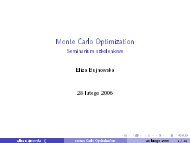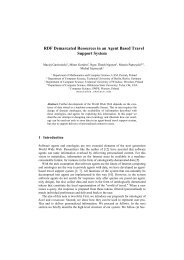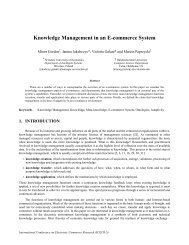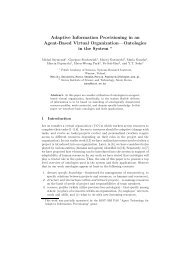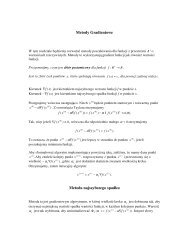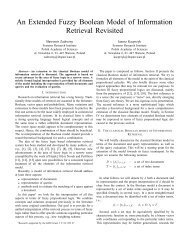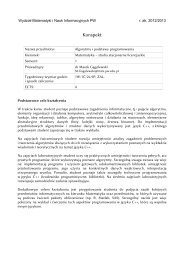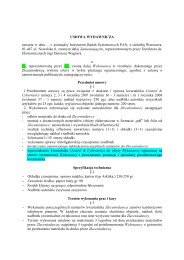Combining Information from Multiple Internet Sources
Combining Information from Multiple Internet Sources
Combining Information from Multiple Internet Sources
You also want an ePaper? Increase the reach of your titles
YUMPU automatically turns print PDFs into web optimized ePapers that Google loves.
3.3 Consensus method<br />
The Consensus method was used previously in the AGWI system [1]. The Consensus<br />
approach for conflict solving has been widely described by Nguyen N.T. in [4]. Its main aim is:<br />
given a set of answers reach the common agreement on what the final combined answer should be.<br />
It has been applied to be used in the application under considerations, however with slight<br />
differences. The main assumptions of this approach were not altered – consensus answer is created<br />
at the beginning and then its consistency is evaluated. The consistency part has been slightly<br />
modified. One of steps performed in this algorithm is measuring of distances between result sets.<br />
Modification changes the way; the evaluation of distances takes place. Another difference lies in the<br />
method of choosing of the search engines for results retrieval. In the AGWI system there were more<br />
search engines than there were Search Agents. In this case there are as many Search Agents as there<br />
are search engines which are to be utilized.<br />
First, the result sets are evaluated. A combined result set (without repetition of URLs) <strong>from</strong><br />
all result sets is created. Then for each URL its average position in result sets is calculated. After<br />
that the combined result sets is sorted according to the average positions. The consensus answer is<br />
found. Afterwards, it remains to check its consistency.<br />
Listing 3.3.1 presents the pseudo code of algorithm for finding the consensus answer.<br />
Input: Map of results<br />
r 1, 2 ,...,<br />
i<br />
a ,<br />
i i i i<br />
= U U U n where U i , U<br />
i<br />
2 ,...,<br />
U<br />
i<br />
n<br />
result sets.<br />
Output: Consensus answer<br />
r<br />
i<br />
provided by m Search Agents – each in the form<br />
1 are URLs. Map containing weights for<br />
BEGIN<br />
1. create setURLS<strong>from</strong> all URLs <strong>from</strong> all result sets (without<br />
repetitions)<br />
2. for each U ∈ URLS<br />
-create array<br />
( i)<br />
r ;<br />
t , t 2<br />
,...,<br />
t<br />
1 n<br />
where i<br />
t is position on which U appears in<br />
- if U does not appear in r<br />
( i)<br />
then set t i<br />
as the length of the longest<br />
ranking increased by 1<br />
- divide each i<br />
- calculate average ( U )<br />
(i)<br />
( i)<br />
t by weight ( r ); if ( r ) = 0<br />
t of values t 1<br />
, t 2<br />
,...,<br />
tn<br />
Listing 3.3.1 Consensus method main algorithm<br />
33<br />
weight divide by 0.01<br />
3. consensus answer is obtained by ordering elements of URLSaccording<br />
END<br />
to values t ( U )



